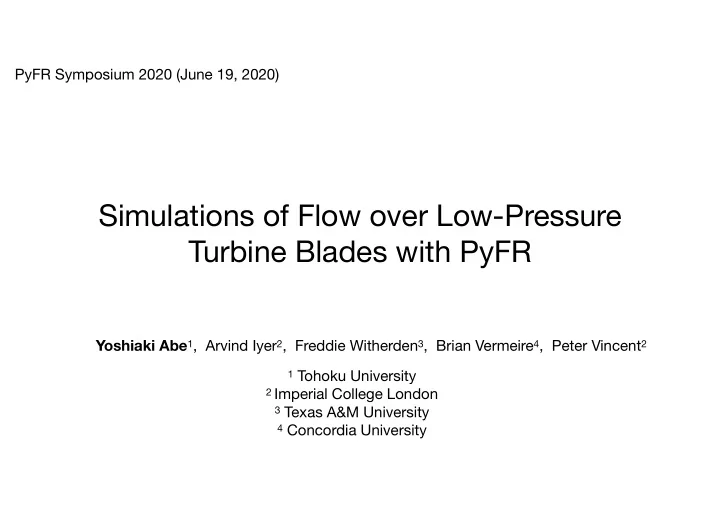

PyFR Symposium 2020 (June 19, 2020) Simulations of Flow over Low-Pressure Turbine Blades with PyFR Yoshiaki Abe 1 , Arvind Iyer 2 , Freddie Witherden 3 , Brian Vermeire 4 , Peter Vincent 2 1 Tohoku University 2 Imperial College London 3 Texas A&M University 4 Concordia University
Motivation • Designing ‘greener aircraft’ • Engine weight is a critical parameter for the aircraft that uses gas turbine engines • Modern turbines are designed to use as few blades as possible • It results in higher-loading blades to turn flows, and thus the flow is often separated • Scale resolving simulations such as a direct numerical simulation (DNS) is demanded https://www.mtu.de/engines/
Motivation • Designing ‘greener aircraft’ • Engine weight is a critical parameter for the aircraft that uses gas turbine engines • Modern turbines are designed to use as few blades as possible • It results in higher-loading blades to turn flows, and thus the flow is often separated • Scale resolving simulations such as a direct numerical simulation (DNS) is demanded
Motivation • Designing ‘greener aircraft’ • Engine weight is a critical parameter for the aircraft that uses gas turbine engines • Modern turbines are designed to use as few blades as possible • It results in higher-loading blades to turn flows, and thus the flow is often separated • Scale resolving simulations such as a direct numerical simulation (DNS) is demanded Construct precise database for turbulence modeling
Experimental setup • MTU T161 low-pressure turbine blade with diverging end-walls • Wind tunnel experiments by MTU Aero engines (turbulent inlet / 7 blades) • Chord-based Reynolds number is Re=90,000 and 200,000 • Ma ~ 0.6 ( Ma inlet = 0.38, Ma outlet = 0.55) • Diverging end-walls
Simulation setup • MTU T161 low-pressure turbine blade with diverging end-walls • Chord-based Reynolds number is Re=90,000 and 200,000 • Ma ~ 0.6 ( Ma inlet = 0.38, Ma outlet = 0.55) • Laminar inlet simulation (Re = 90,000 and 200,000) and Turbulent inlet simulation (Re = 90,000)
Simulation setup • MTU T161 low-pressure turbine blade with diverging end-walls • Flux-Reconstruction scheme (solution polynomial: p = 4) • Number of total DoF = 2.3 billion (Re=90k), 11 billion (Re=200k) • Average ~200 quantities for turbulent statistics including double/triple/ quadruple products and gradient terms • 660 point probes for time history of primitive variables
8 Simulation setup (laminar inflow) • MTU T161 low-pressure turbine blade with diverging end-walls y x z A total pressure p t1 is fixed => the velocity profile is determined as a ghost state • The total pressure profile is set to follow • the Blasius-like boundary layer velocity profile [1] in the span-wise direction [1] O. Savas, Commun Nonlinear Sci Numer Simul., Vol. 17, Issue 10, 2012, pp. 3772-3775. The static pressure is assumed to be uniform •
Governing Equations Compressible and Incompressible Navier-Stokes - Arbitrary order Flux Reconstruction on mixed unstructured grids (hexes, tets, prisms etc.) Spatial Discretisation - p4 with full anti-aliasing option in this study (volume, flux, surf-flux) Explicit Runge-Kutta schemes (RK45) with time-step size Temporal Discretisation controller CPU clusters (via C/OpenMP-MPI) Platforms Nvidia GPU clusters (via CUDA-MPI) AMD GPU clusters (via OpenCL-MPI)
Results Takes ~ 24 hours of wall clock time per blade pass on 5,760 K20X GPUs • (for Re=200k case) Simulation for ~12 flow passes for time averaging •
Re = 200,000 (laminar inlet) Density gradient Q isosurface
Re = 200,000 (laminar inlet) Resolution 1 Delta y+ 0.5 0 0.65 0.7 0.75 0.8 0.85 Chord PyFR
Re = 200,000 (laminar inlet) Isentropic Mach number on the mid-span blade surface 1 . 2 1BLI-200 simulation Experiment: Re = 2 . 0 × 10 5 1 . 0 Isentropic Mach number 0 . 8 0 . 6 0 . 4 0 . 2 0 . 0 0 . 0 0 . 2 0 . 4 0 . 6 0 . 8 1 . 0 Normalized axial chord length
Re = 200,000 (laminar inlet) Total pressure loss in wake
Re = 200,000 (laminar inlet) Total pressure loss in wake
Re = 200,000 (laminar inlet) Blade shear stress LIC Suction side Pressure side PyFR Experiment
Re = 200,000 and 90,000 (laminar inlet) Re=200k Re=90k
Re = 200,000 and 90,000 (laminar inlet) Total pressure loss in wake Re=200k Re=90k
Inlet turbulence y x z • Impose random velocity fluctuation to the laminar profile (as a ghost state) • Digital filter (DF) technique proposed by Klein et al. JCP 2003, Xie and Castro Flow Turbul. Combust. 2008 • Implementation follows Touber and Sandham Theor. Comput. Fluid. Dyn. 2009 • Impose density fluctuation via the strong Reynolds analogy (SRA) by Guarini et al., JFM 2000
Re = 90,000 Laminar inlet Turbulence inlet
Re = 90,000 Laminar inlet Turbulence inlet
Re = 90,000 Laminar inlet Turbulence inlet Simulation (laminar) Simulation (1.25% turbulence) Experiment (2% turbulence) Simulation (1.25% turbulence) Simulation (laminar) Experiment (4% turbulence) Experiment (4% turbulence) Experiment (2% turbulence) Experiment (2% turbulence)
Summary • DNS for MTU T161 LPT cascade with non-parallel end- walls was performed using 5760 NVIDIA GPUs (K20X) on Titan at Oak Ridge National laboratories • Good agreement with experiments in Re=200k case without turbulence inlet condition • Re=90k case with/without inlet turbulence • Inlet turbulence delays separation on suction-side • Re=90k case is relatively sensitive to the inlet turbulence compared to the Re=200k case
Recommend
More recommend